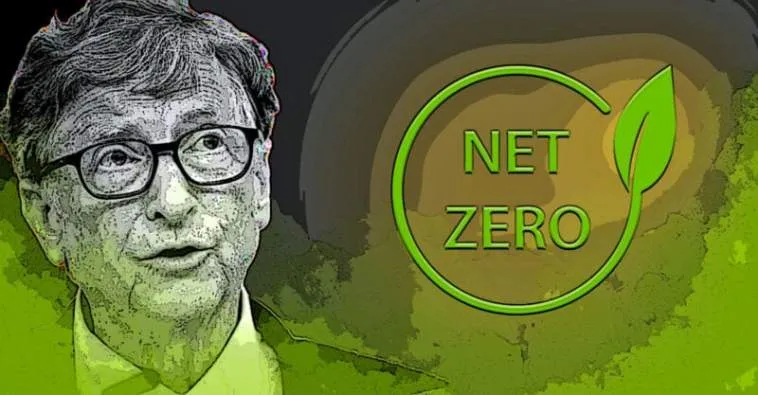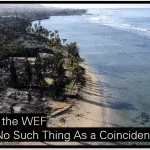(The Defender) Bill Gates is known as one of the world’s leading proponents of “net zero.” The tech billionaire said that reaching “net zero” greenhouse gas emissions by the year 2050 will be “the most difficult challenge humanity has ever taken on” and “the most amazing thing humanity has ever done.”
Shifting the world’s greenhouse gas emissions from today’s 52 billion tons to net zero over the next three decades, according to Gates, means “we need to find better ways to do pretty much everything” from the “food we eat” to the “buildings we live in,” because “[v]irtually every human activity produces greenhouse gas emissions.”
But when Gates refers to “net zero,” he does not mean actual zero, as in no emissions.
Adding the word “net” into the equation for redoing “virtually every human activity” substantially changes the meaning of “zero.”
And Gates has helped convince most countries of the world to add that small, poorly understood, seemingly harmless word “net” into their climate change pledges.
So what, exactly, does net zero emissions mean to Gates and others who share his ambitions?
Ecological activist Vandana Shiva, Ph.D., told The Defender:
“‘Net zero,’ as Bill Gates admits in his book, ‘How to Avoid a Climate Disaster,’ is not about polluters stopping their pollution. It is about polluters getting new profits by creating new markets for fake techno-fixes like geoengineering and fake food, and new forms of land grab through ‘carbon offsets.’
“Net zero is a financial scam like the subprime crisis of 2008, which led to the collapse of Wall Street and entire economies.”
The future implications of net zero are far-reaching. The worldwide push for net zero has turned “carbon credits” into globally traded financial instruments, giving big corporations and billionaires a kind of “license to pollute.”
The global “carbon market” has established new ways for economic elites to grab land, profit from dubious technologies and attempt to corner the market on literally any activity that produces carbon, potentially encompassing “virtually every human activity,” in Gates’ words.
History of net zero and its potential for abusegreenThe concept of net zero existed primarily in academic papers and reports until it was incorporated into the 2015 Paris Agreement, at the urging of powerful advocates. Since then, the world’s commitment to “net” zero has exploded.
Shiva recently told Russell Brand, “I watched Bill Gates take over the U.N. [United Nations] system with the climate summit in Paris in 2015.”
And in another interview, Shiva said this about Gates.
“He cooked up a word, which I had never heard before that, called ‘net zero.’ And he said we have to solve climate problems by net zero.
“It doesn’t mean we get rid of emissions. He flies in a private jet and has all the private jet services of the world. He says it doesn’t mean we will stop polluting. He says it just means we have to find other people’s lands for offsets to absorb our pollution.”
Here is how net zero is supposed to work.
In Article 4 of The Paris Agreement, the parties agreed that sources of emissions must be “balanced” by “removals” of greenhouse gases.
Article 6 referred to “internationally transferred mitigation outcomes,” meaning carbon credits that can be bought, sold and traded across international borders.
The Paris Agreement has led to the emergence of a global “carbon market” in which governments and private actors buy and sell credits by funding activities that reduce or avoid carbon emissions, or those that remove carbon from the atmosphere.
Removal credits can be obtained through technological methods of removal such as “direct air capture” — a technology as yet unproven at scale — or through land-based methods such as the preservation of forests and sequestering of carbon in farmland soil.
Big emitters that obtain credits can use them to “offset” their emissions, so they don’t actually have to make any cuts.
This idea of achieving “net zero” via a global market for carbon credits was a departure from an earlier understanding of how climate change should be addressed, according to Shiva.
“Stopping the pollution that is driving climate chaos and climate destabilization is an ecological obligation, both to protect the rights of the Earth as a living organism and the human rights of those lives we are losing because of climate catastrophes,” Shiva told The Defender.
“That means we must move towards ‘real zero’ in terms of emissions. Since the .1% is responsible for most of the pollution, the polluters must stop polluting, and as was agreed in Rio at the Earth Summit, polluters must pay,” she said.
Net zero turned this logic on its head, giving big polluters the right to financially buy up “emissions rights.” This is how carbon credits became “Wall Street’s favorite climate solution.”
“The former Bank of England governor, Mark Carney, now heads the U.N. Net Zero initiative,” Shiva said, “which is being described as ‘changing the plumbing of the whole financial system forever.’”
With this kind of financial power behind it, the global drive for net zero has taken off since the 2015 Paris Agreement. By 2019, countries covering one-sixth of the global economy had made net zero pledges, and by 2021, net zero pledges covered nine-tenths of the global economy.
In July, Gates said the next U.N. climate conference — COP28, to be held Nov. 30-Dec. 12 — “will be a critical opportunity for the world’s leaders to come together and take real steps to accelerate our path to net-zero carbon emissions.”
#COP28 will be a critical opportunity for the world’s leaders to come together and take real steps to accelerate our path to net-zero carbon emissions. https://t.co/8EYri4XNbw
— Bill Gates (@BillGates) July 26, 2023






